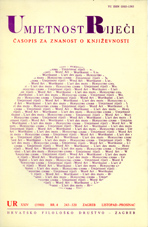"Formalna" i "sociološka" analiza: primjer naučno-fantastičkog romana
"Formal" and "Sociological" Analysis: the Example of the Science-Fiction Novel
Author(s): Darko SuvinSubject(s): Literary Texts
Published by: Hrvatsko filološko društvo
Summary/Abstract: Thirteen SF novels from H.G. Wells, Zamiatin and Stapledon to the Strugatskii Brothers, John Brunner and Ursula Le Guin are examined in respect of the novum as plot generator and the ending. The first part examines the consequences of the novum (a concept developed in my book Metamorphoses of Science Fiction, Yale U. P. 1979) to the plot. If the polar opposites of fiction are a "mythological" structure with cyclical time and an "epic" structure with developing time, then modern SF is under the hegemony of the epic, regardless of the remnants of the mythological ,,revelation as inventory" technique: the novum demands a unique series of events with irreconciliably different figures and configurations, achieving novelistic unity by metaphor or metonymy but not by mythical homeomorphy. Therefore, the quality of the "other" is the crucial test of the SF novum; this is achieved in Wells's First Men in the Moon but not in The War of the Worlds, in Dick's Martian Time-Slip but not in Asimov's Foundation Trilogy. Their narrative agents and configurations cannot be ,,formally" judged without using the "sociological" concept of verisimilitude; the distinction between extrinsic and intrinsic analysis of fiction is no longer satisfactory. The second part examines the ending, that crucial diegetic segment which valorizes all the preceding ones and steers the application of the reading to empirical reality. The syntagmatics of an "epic" text necessitate axiological choices where a ,,mythological" text has a pre-established sequentiality; the ending is the sum of all such choices, the moment of truth for the novum's cognitive validation and the narration's verisimilitude in SF. Ideally, "epic" structures should be open-ended (Lotman, Eco, Klotz, Brecht), but historical ideologies modify such an Idealtyp into a number of ending-types spanning the formal gamut. Verne's novels are almost perfectly closed and cyclical, they have to end by expunging the novum; Wells and Zamiatin made an aesthetic form out of hesitations about the radically Other, about openness vs. closure. Mass Anglo-American and Slavic SF after World War 2 can, paradoxically, establish their dystopias as such only against an implicit, often non-existent but always necessary, bright background or quasi-utopian horizon. Their endings are defined by how they reconcile the principles of hope and of reality: as escape into mythological certainty (Asimov, Pohl-Kornbluth, Heinlein) or as open-ended poliphony with different axiological possibilities according to circumstances (Dick, the Strugatskii Brothers, Brunner). Open-endedness is characteristic also of the return of utopia within SF, from the early Lem and Efremov to Le Guin's The Dispossessed and Piercy's Woman on the Edge of Time in the 1970s.
Journal: Umjetnost riječi
- Issue Year: 1980
- Issue No: 4
- Page Range: 295-302
- Page Count: 8
- Language: Croatian

